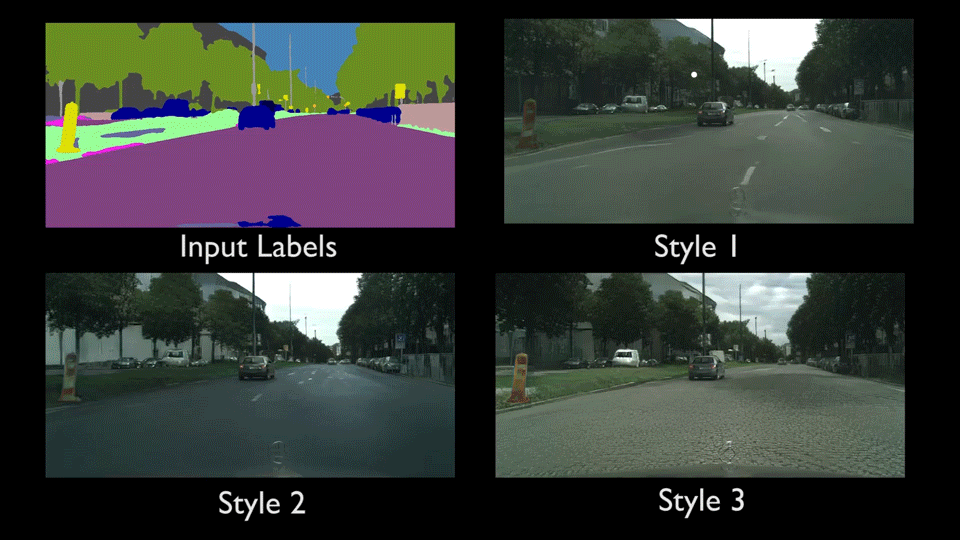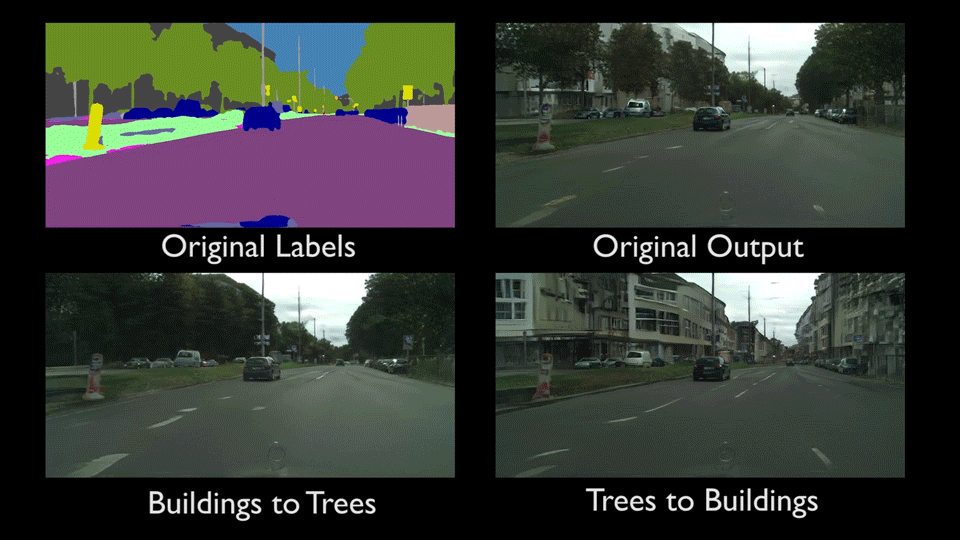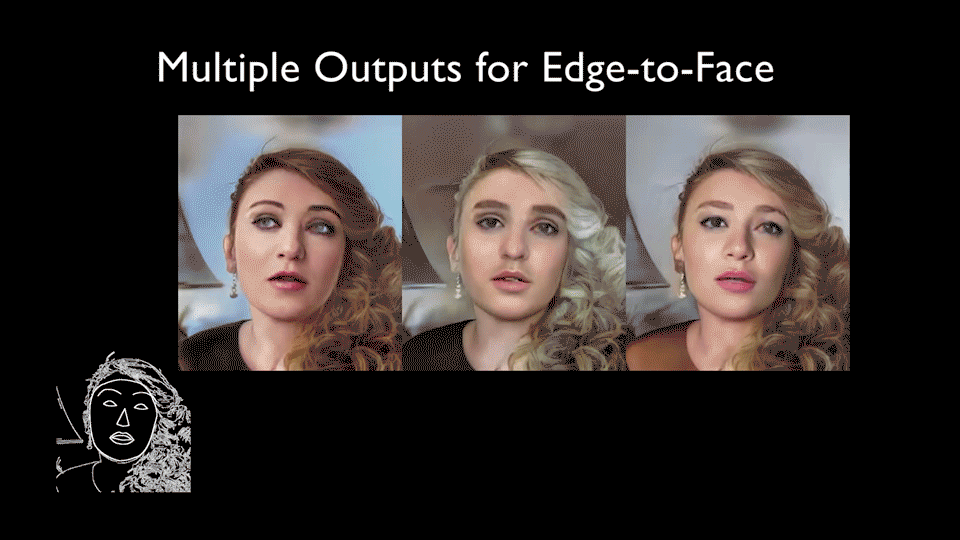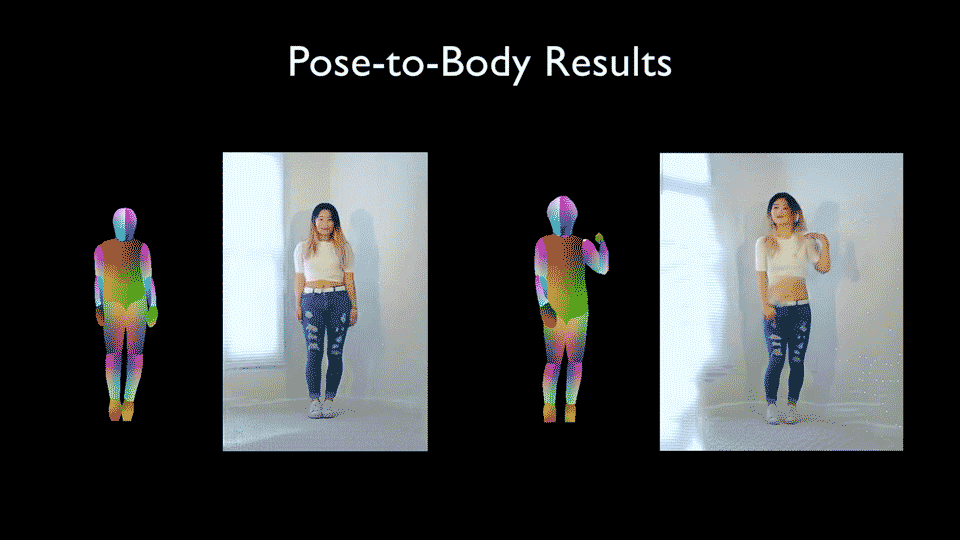Pytorch implementation for high-resolution (e.g., 2048x1024) photorealistic video-to-video translation. It can be used for turning semantic label maps into photo-realistic videos, synthesizing people talking from edge maps, or generating human motions from poses.
Video-to-Video Synthesis
Ting-Chun Wang1, Ming-Yu Liu1, Jun-Yan Zhu2, Guilin Liu1, Andrew Tao1, Jan Kautz1, Bryan Catanzaro1
1NVIDIA Corporation, 2MIT CSAIL
In arXiv, 2018.
- Label-to-Streetview Results
- Edge-to-Face Results
- Pose-to-Body Results
- Linux or macOS
- Python 3
- NVIDIA GPU + CUDA cuDNN
- PyTorch 0.4
- Install python libraries dominate and requests.
pip install dominate requests- Clone this repo:
git clone https://github.com/NVIDIA/vid2vid
cd vid2vid-
We include an example Cityscapes video in the
datasetsfolder. -
First, download and compile a snapshot of FlowNet2 by running
python scripts/download_flownet2.py. -
Please download the pre-trained Cityscapes model by:
python scripts/download_models.py
-
To test the model (
bash ./scripts/test_2048.sh):#!./scripts/test_2048.sh python test.py --name label2city_2048 --dataroot datasets/Cityscapes/test_A --loadSize 2048 --n_scales_spatial 3 --use_instance --fg --use_single_GThe test results will be saved to a HTML file here:
./results/label2city_2048/test_latest/index.html. -
We also provide a smaller model trained with single GPU, which produces slightly worse performance at 1024 x 512 resolution.
- Please download the model by
python scripts/download_models_g1.py
- To test the model (
bash ./scripts/test_1024_g1.sh):
#!./scripts/test_1024_g1.sh python test.py --name label2city_1024_g1 --dataroot datasets/Cityscapes/test_A --loadSize 1024 --n_scales_spatial 3 --use_instance --fg --n_downsample_G 2 --use_single_G -
You can find more example scripts in the
scriptsdirectory.
- We use the Cityscapes dataset as an example. To train a model on the full dataset, please download it from the official website (registration required).
- We apply a pre-trained segmentation algorithm to get the corresponding semantic maps (train_A) and instance maps (train_inst).
- Please add the obtained images to the
datasetsfolder in the same way the example images are provided.
-
First, download the FlowNet2 checkpoint file by running
python scripts/download_models_flownet2.py. -
Training with 8 GPUs:
- We adopt a coarse-to-fine approach, sequentially increasing the resolution from 512 x 256, 1024 x 512, to 2048 x 1024.
- Train a model at 512 x 256 resolution (
bash ./scripts/train_512.sh)
#!./scripts/train_512.sh python train.py --name label2city_512 --gpu_ids 0,1,2,3,4,5,6,7 --n_gpus_gen 6 --n_frames_total 6 --use_instance --fg- Train a model at 1024 x 512 resolution (must train 512 x 256 first) (
bash ./scripts/train_1024.sh):
#!./scripts/train_1024.sh python train.py --name label2city_1024 --loadSize 1024 --n_scales_spatial 2 --num_D 3 --gpu_ids 0,1,2,3,4,5,6,7 --n_gpus_gen 4 --use_instance --fg --niter_step 2 --niter_fix_global 10 --load_pretrain checkpoints/label2city_512 -
To view training results, please checkout intermediate results in
./checkpoints/label2city_1024/web/index.html. If you have TensorFlow installed, you can see TensorBoard logs in./checkpoints/label2city_1024/logsby adding--tf_logto the training scripts. -
Training with a single GPU:
- We trained our models using multiple GPUs. For convenience, we provide some sample training scripts (XXX_g1.sh) for single GPU users, up to 1024 x 512 resolution. Again a coarse-to-fine approach is adopted (256 x 128, 512 x 256, 1024 x 512). Performance is not guaranteed using these scripts.
- For example, to train a 256 x 128 video with a single GPU (
bash ./scripts/train_256_g1.sh)
#!./scripts/train_256_g1.sh python train.py --name label2city_256_g1 --loadSize 256 --use_instance --fg --n_downsample_G 2 --num_D 1 --max_frames_per_gpu 6 --n_frames_total 6
- To train the images at full resolution (2048 x 1024) requires 8 GPUs with at least 24G memory (
bash ./scripts/train_2048.sh). If only GPUs with 12G/16G memory are available, please use the script./scripts/train_2048_crop.sh, which will crop the images during training. Performance is not guaranteed with this script.
- If your input is a label map, please generate label maps which are one-channel whose pixel values correspond to the object labels (i.e. 0,1,...,N-1, where N is the number of labels). This is because we need to generate one-hot vectors from the label maps. Please use
--label_nc Nduring both training and testing. - If your input is not a label map, please specify
--label_nc 0and--input_nc Nwhere N is the number of input channels (The default is 3 for RGB images). - The default setting for preprocessing is
scaleWidth, which will scale the width of all training images toopt.loadSize(1024) while keeping the aspect ratio. If you want a different setting, please change it by using the--resize_or_cropoption. For example,scaleWidth_and_cropfirst resizes the image to have widthopt.loadSizeand then does random cropping of size(opt.fineSize, opt.fineSize).cropskips the resizing step and only performs random cropping.scaledCropcrops the image while retraining the original aspect ratio. If you don't want any preprocessing, please specifynone, which will do nothing other than making sure the image is divisible by 32.
- We generate frames in the video sequentially, where the generation of the current frame depends on previous frames. To generate the first frame for the model, there are 3 different ways:
-
- Using another generator which was trained on generating single images (e.g., pix2pixHD) by specifying
--use_single_G. This is the option we use in the test scripts.
- Using another generator which was trained on generating single images (e.g., pix2pixHD) by specifying
-
- Using the first frame in the real sequence by specifying
--use_real_img.
- Using the first frame in the real sequence by specifying
-
- Forcing the model to also synthesize the first frame by specifying
--no_first_img. This must be trained separately before inference.
- Forcing the model to also synthesize the first frame by specifying
-
- The way we train the model is as follows: suppose we have 8 GPUs, 4 for generators and 4 for discriminators, and we want to train 28 frames. Also, assume each GPU can generate only one frame. The first GPU generates the first frame, and pass it to the next GPU, and so on. After the 4 frames are generated, they are passed to the 4 discriminator GPUs to compute the losses. Then the last generated frame becomes input to the next batch, and the next 4 frames in the training sequence are loaded into GPUs. This is repeated 7 times (4 x 7 = 28), to train all the 28 frames.
- Some important flags:
n_gpus_gen: the number of GPUs to use for generators (while the others are used for discriminators). We separate generators and discriminators into different GPUs since when dealing with high resolutions, even one frame cannot fit in a GPU. If the number is set to-1, there is no separation and all GPUs are used for both generators and discriminators (only works for low-res images).n_frames_G: the number of input frames to feed into the generator network; i.e.,n_frames_G - 1is the number of frames we look into the past. the default is 3 (conditioned on previous two frames).n_frames_D: the number of frames to feed into the temporal discriminator. The default is 3.n_scales_spatial: the number of scales in the spatial domain. We train from the coarsest scale and all the way to the finest scale. The default is 3.n_scales_temporal: the number of scales for the temporal discriminator. The finest scale takes in the sequence in the original frame rate. The coarser scales subsample the frames by a factor ofn_frames_Dbefore feeding the frames into the discriminator. For example, ifn_frames_D = 3andn_scales_temporal = 3, the discriminator effectively sees 27 frames. The default is 3.max_frames_per_gpu: the number of frames in one GPU during training. If your GPU memory can fit more frames, try to make this number bigger. The default is 1.max_frames_backpropagate: the number of frames that loss backpropagates to previous frames. For example, if this number is 4, the loss on frame n will backpropagate to frame n-3. Increasing this number will slightly improve the performance, but also cause training to be less stable. The default is 1.n_frames_total: the total number of frames in a sequence we want to train with. We gradually increase this number during training.niter_step: for how many epochs do we doublen_frames_total. The default is 5.niter_fix_global: if this number if not 0, only train the finest spatial scale for this number of epochs before starting to fine-tune all scales.batchSize: the number of sequences to train at a time. We normally set batchSize to 1 since often, one sequence is enough to occupy all GPUs. If you want to do batchSize > 1, currently onlybatchSize == n_gpus_genis supported.no_first_img: if not specified, the model will assume the first frame is given and synthesize the successive frames. If specified, the model will also try to synthesize the first frame instead.fg: if specified, use the foreground-background separation model as stated in the paper. The foreground labels must be specified by--fg_labels.
- For other flags, please see
options/train_options.pyandoptions/base_options.pyfor all the training flags; seeoptions/test_options.pyandoptions/base_options.pyfor all the test flags.
If you find this useful for your research, please cite the following paper.
@article{wang2018vid2vid,
title={Video-to-Video Synthesis},
author={Ting-Chun Wang and Ming-Yu Liu and Jun-Yan Zhu and Guilin Liu and Andrew Tao and Jan Kautz and Bryan Catanzaro},
journal={arXiv preprint arXiv:1808.06601},
year={2018}
}
We thank Karan Sapra, Fitsum Reda, and Matthieu Le for generating the segmentation maps for us. We also thank Lisa Rhee for allowing us to use her dance videos for training. We thank William S. Peebles for proofreading the paper.
This code borrows heavily from pytorch-CycleGAN-and-pix2pix and pix2pixHD.





